GRAPHING PIECEWISE FUNCTIONS
Subscribe to our ▶️ YouTube channel 🔴 for the latest videos, updates, and tips.
Subscribe to our ▶️ YouTube channel 🔴 for the latest videos, updates, and tips.
A piecewise function is a function defined by two or more equations. Each “piece” of the function applies to a different part of its domain. An example is shown below.

- The expression x − 2 represents the value of f when x is less than or equal to 0.
- The expression 2x + 1 represents the value of f when x is greater than 0.
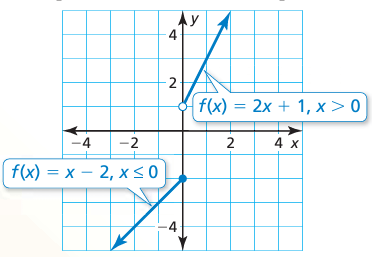
Carefully graph each of the following. Identify whether or not the graph is a function. Then, evaluate the graph at any specified domain value. You may use your calculators to help you graph, but you must sketch it carefully.
Problem 1 :

i) Check if the graph is a function or not.
ii) Evaluate
a) f(3) b) f(-4) c) f(-2)
Solution :
Graphing Line :
Graphing y = x + 5, where x < -2
Since it is linear, we can compare the given with y = mx + b, slope = 1 and y-intercept = 5. It must be a raising line with y-intercept of 5
|
x-intercept : y = 0 x + 5 = 0 x = -5 |
y-intercept : x = 0 0 + 5 = y y = 5 |
Domain of the line is (- ∞, 2)
Graphing parabola :
Converting x2 + 2x + 3 into vertex form,
= x2 + 2x + 3
= x2 + 2 x (1) + 12 - 12 + 3
= (x + 1)2 - 1 + 3
= (x + 1)2 + 2
(h, k ) ==> (-1, 2)
Domain of the parabola is [2, ∞).
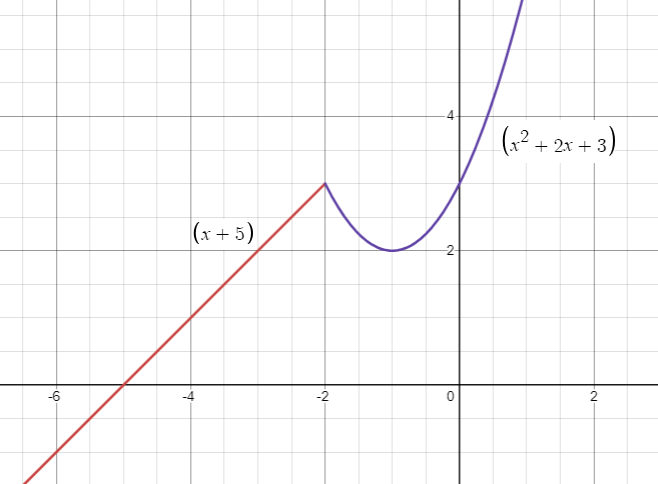
i) Drawing the vertical line through the graph, the line will intersect the graph maximum once. So, it is a function.
ii) a) f(3) :
x = 3 it satisfies the condition ≥ -2
f(x) = x2 + 2x + 3
f(-3) = (-3)2 + 2(-3) + 3
= 9 - 6 + 3
= 12 - 6
= 6
b) f(-4) :
x = -4 it satisfies the condition < -2
f(x) = x + 5
f(-4) = -4 + 5
= 1
c) f(-2) :
x = -2, it satisfies the condition ≥ -2
f(x) = x2 + 2x + 3
f(-2) = (-2)2 + 2(-2) + 3
= 4 - 4 + 3
f(-2) = 3
Problem 2 :

i) Check if the graph is a function or not.
ii) Evaluate
a) f(-2) b) f(6) c) f(1)
Solution :
Graphing Line :
y = 2x + 1
Slope = 2 and y-intercept = 1
x-intercept, put y = 0
2x + 1 = 0
2x = -1
x = -1/2
Domain of line is [1, ∞).
Graphing parabola :
y = x2 + 3
Vertex form :
y = (x - 0)2 + 3
Vertex (h, k) ==> (0, 3)
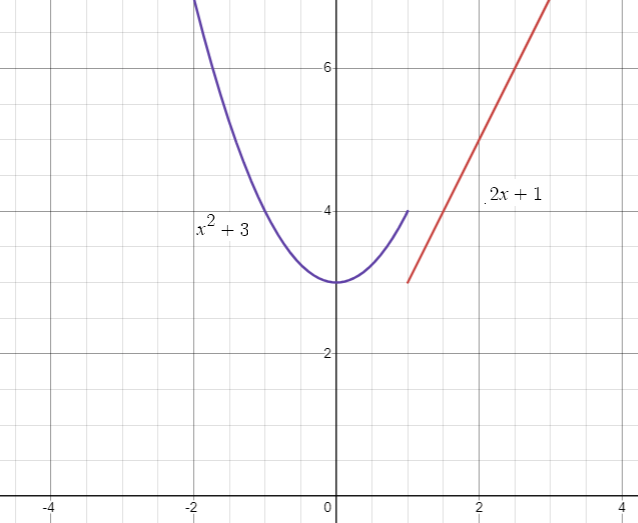
Domain of parabola is -(∞, 1).
i) Using vertical line test, it is a function.
ii)
a) f(-2) :
Here x = -2, which satisfies the condition x < 1
f(x) = x2 + 3
f(-2) = (-2)2 + 3
= 4 + 3
= 7
b) f(6)
Here x = 6, which satisfies the condition x ≥ 1
f(x) = 2x + 1
f(6) = 2(6) + 1
= 12 + 1
= 13
c) f(1)
Here x = 1, which satisfies the condition x ≥ 1
f(x) = 2x + 1
f(1) = 2(1) + 1
= 3
Problem 3 :

i) Check if the graph is a function or not.
ii) Evaluate
a) f(-4) b) f(8) c) f(2)
Solution :
Graphing first line :
y = -2x + 1
Slope = -2 and y-intercept = 1
It is a falling line with slope -2.
|
x-intercept : Put y = 0 0 = -2x + 1 -2x = -1 x = 1/2 |
y-intercept : Put x = 0 y = -2(0) + 1 y = 1 |
Graphing second line :
y = 5x - 4
Slope = 5 and y-intercept = -4
Since the domain is > 2, then we cannot mark the y-intercept.
It is a raising line with slope 5.
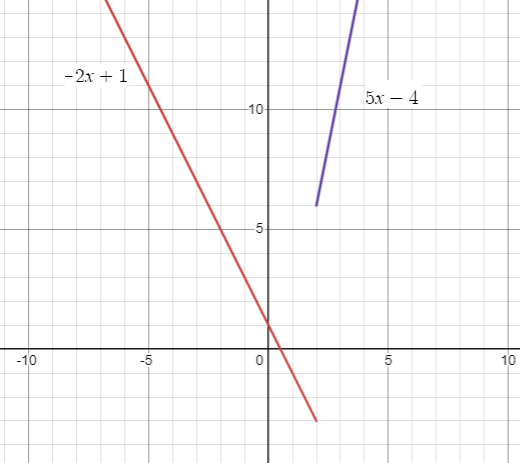
ii)
a) f(-4)
Here x = -4 satisfying the condition x ≤ 2
f(x) = -2x + 1
f(-4) = -2(-4) + 1
= 8 + 1
f(-4) = 9
b) f(8)
Here x = 8 satisfying the condition x > 2
f(x) = 5x - 4
f(8) = 5(8) - 4
= 40 - 4
f(8) = 36
c) f(2)
Here x = 2 satisfying the condition x ≤ 2
f(x) = -2x + 1
f(2) = -2(2) + 1
= -4 + 1
f(2) = -3
Problem 4 :
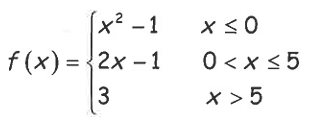
Solution :
Graphing first piece :
f(x) = x2 - 1
Writing in the vertex form, we get
f(x) = (x - 0)2 - 1
Here the vertex is (0, -1).
Graphing second piece :
f(x) = 2x - 1
It is a straight line, with slope = 2 and y-intercept = -1
At x = 5, we have to draw the filled circle.
Graphing third piece :
f(x) = 3
Put the filled circle.
At 5, we have to draw the unfilled circle and continue drawing line.
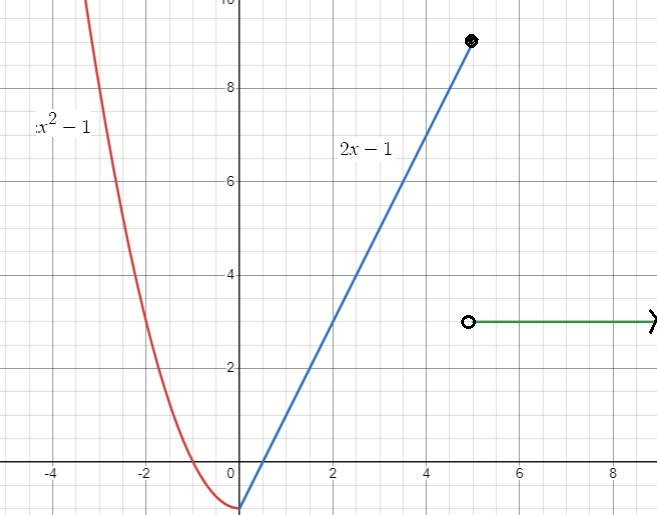
Recent Articles
-
Finding Range of Values Inequality Problems
May 21, 24 08:51 PM
Finding Range of Values Inequality Problems -
Solving Two Step Inequality Word Problems
May 21, 24 08:51 AM
Solving Two Step Inequality Word Problems -
Exponential Function Context and Data Modeling
May 20, 24 10:45 PM
Exponential Function Context and Data Modeling